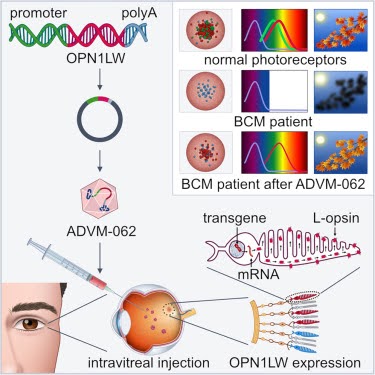A Colorful Cure: How Gene Therapy Is Treating Blue Cone Monochromacy
(Posted on Tuesday, December 19, 2023)
This story is part of a series on the current progression in Regenerative Medicine. This piece is part of a series dedicated to the eye and improvements in restoring vision.
In 1999, I defined regenerative medicine as the collection of interventions that restore tissues and organs damaged by disease, injured by trauma, or worn by time to normal function. I include a full spectrum of chemical, gene, and protein-based medicines, cell-based therapies, and biomechanical interventions that achieve that goal.
Color blindness affects millions worldwide, with Blue Cone Monochromacy (BCM) being a rare form of this condition, affecting about one in every 100,000 people. BCM is a genetic disorder resulting from the absence or damage of the genes responsible for the blue photopigment in the retina cones. This leads to reduced color perception and poor visual acuity, making daily activities such as selecting matching clothes, identifying objects in traffic lights, or distinguishing between colors more difficult.
Recent advances in gene therapy offer a promising solution to this condition. Gene therapy can potentially restore the function of the missing or damaged genes in the retina, allowing for improved color perception and visual acuity. This means that individuals with BCM can look forward to a brighter future where they can better enjoy life’s colorful moments and engage in activities they previously found difficult.
What is Blue Cone Monochromacy?
Blue cone monochromacy (BCM) is a rare X-linked retina disorder. It causes a complete or near-complete loss of function in the L- and M-cones responsible for color vision. As a result, individuals with BCM rely only on their S-cones, which detect short-wavelength light, to see the world around them.
It is important to note that individuals with BCM do not see the world in just one color, blue. Instead, they see the world in shades of blue, yellow, and gray without perceiving red, green, or other distinct colors. This significantly impacts their ability to distinguish colors, recognize faces, and perform tasks that rely on color vision, such as driving.
Blue cone monochromacy (BCM) is caused by mutations in the OPN1LW and OPN1MW genes found on the X chromosome. These genes encode proteins that are needed in the process of converting light into electrical signals that the brain uses for visual processing. The proteins are called L- and M-cone opsins, which play a crucial role in this process.
When there are mutations in these genes, the L- and M-cone opsins’ structure and function can be affected. This impairment can result in a loss of L- and M-cones or in their dysfunction. The loss of L- and M-cones or their dysfunction compromises the power of the retina to distinguish colors and process visual information accurately.
Treating BCM Color Blindness
There are optical treatments that can help alleviate the symptoms of BCM. Two options are spectral-filtering contact lenses and tinted glasses. Spectral-filtering contact lenses block specific light wavelengths, which improves color discrimination. Tinted glasses enhance color vision and help people with BCM differentiate colors better.
Assistive technology has also proven to be an effective way of managing the disorder. Computer software programs and smartphone applications that provide color labels can help individuals with BCM identify colors more easily. Additionally, colorimeters, color identification systems, and monitors can aid in color identification, making everyday activities easier.
More invasive interventions, such as retinal implants and gene therapy, are currently being researched and have the potential to provide long-term or even permanent treatment for BCM individuals. Retinal implants involve using an electronic device that stimulates the retina, while gene therapy aims to replace the missing cone cells in the retina.
Gene Therapies for Blue Cone Monochromacy
A recent West Virginia University study evaluated gene therapy’s safety and efficacy as a potential cure for blue cone monochromacy (BCM), a spiritual successor to a similar treatment conducted on monkeys in 2009. This previous therapy involved using a virus to deliver the red-green opsin gene to the retinas of squirrel monkeys born entirely colorblind. According to the results, the monkeys gained full-color vision within weeks after receiving treatment.
Fast forward to the present day, and the groundwork laid out by the monkey study paved the way for this recent research exploring gene therapy for BCM. For this study, a virus containing a functional copy of the blue cone photopigment gene was delivered to the retinas of two BCM patients. While the trial was small-scale and limited to a six-month follow-up period, the results were highly encouraging. Both patients experienced significant improvements in color vision, visual acuity, and light sensitivity.
Another study by Adverum Biotechnologies also focused on gene therapy options for BCM. It used ADVM-062, a vector optimized for cone-specific expression of human L-opsin. Unlike existing therapies that involve subretinal vector injection, ADVM-062 can be administered using a single intravitreal (IVT) injection, which poses less risk to the central retinal structure of BCM patients.

Preclinical studies have demonstrated that ADVM-062 effectively transduces gerbil cone photoreceptors and produces a de novo response to long-wavelength stimuli. In non-human primates, ADVM-062 showed cone-specific expression and transduction of foveal cones at specific doses. These findings hold promise for developing a safe and effective treatment for this debilitating and rare disease.
It is important to note that although gene therapy results offer hope for those with BCM, this technology is still in its early stages of development and requires further research to ensure its safety and long-term effectiveness in treating inherited genetic diseases. Nevertheless, this research is a significant advance in gene therapy and demonstrates the potential of this technology to cure genetic diseases that were previously thought to be untreatable.
To learn more about the eye, read more stories at www.williamhaseltine.com

